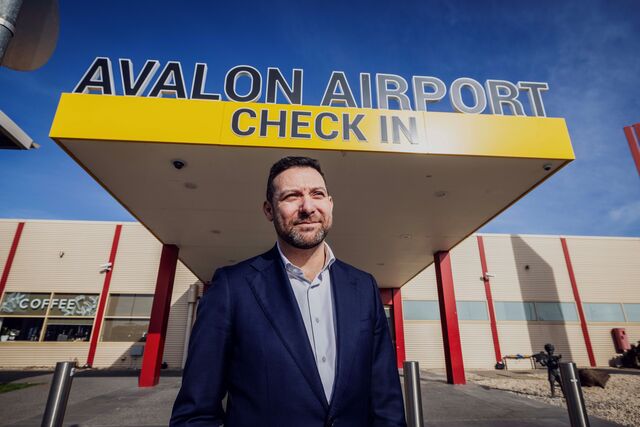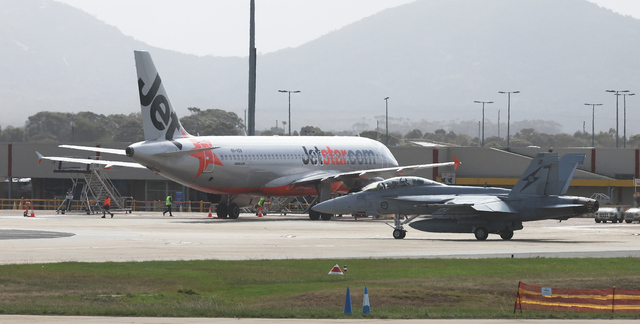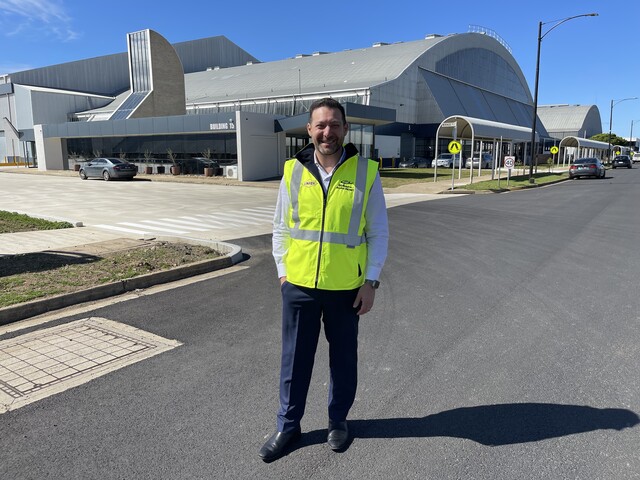Melbourne Avalon Airport and its employment precinct are set to play a pivotal role in the future development of Wyndham and Geelong. Jaidyn Kennedy met with chief executive Ari Suss to discuss the direction Avalon is taking.
Melbourne Avalon Airport may not be making headlines right now, but there is still plenty happening there.
Avalon’s chief executive Ari Suss said while people may naturally focus on flights, it is the expansion of freight capabilities that will drive long-term aviation growth.
Having major companies such as Australia Post, Cotton On and PetStock, set up at Avalon, as well as special defence manufacturers like Lockheed Martin and Hanwha is part of the strategy to drive that growth.
“The investment in those non-aviation projects helps us derive an income that helps us support aviation here,” Mr Suss said.
Avalon has also built a new freight terminal to increase annual air-freight capacity from 10,000 to more than 100,000 tonnes to make it an attractive port for large-scale, scheduled cargo.
“Freight has been traditionally moved in and out of Victoria through Melbourne Airport, and what we know is Tullamarine is increasingly congested,” Mr Suss said.
“Avalon is in the fastest growing corridor in the country and we are seeing the benefits of that in terms of the demand for operational activity here for businesses.”
According to Committee for Wyndham chief executive Leanne Down that growth is why the developing precinct is an unparalleled strategic asset for Wyndham’s future.
“Avalon represents a major opportunity to drive economic growth, create jobs, support tourism, and improve regional connectivity,” she said.
“Having more job opportunities at Avalon means residents can work closer to home, reducing travel time and improving work–life balance.
“A stronger local job market supports families, reduces congestion on roads and public transport, and helps keep skilled workers in Wyndham.”
Committee for Geelong chief executive Michael Johnstone said Avalon would help Greater Geelong harness local talent and elevate Victoria’s second city as a place of business on the global stage.
“Avalon is one of the most significant opportunities to drive economic development in the Geelong region – and this is multi-faceted,” Mr Johnstone said.
“Both as an employment precinct that will eventually see upwards of 15,000 workers on site each day, and as a freight and logistics hub of national significance, connecting air, sea, rail and road.
“There will be an increasing demand for international services into Avalon, and providing that connectivity will in turn further fuel the attractiveness of Geelong as a place to do business.”
While Mr Suss said while driving increased freight operations is a key part of Avalon’s mandate, he hasn’t forgotten the expectations of many Victorians.
“We understand and are very sensitive to the social licence that we have by running an airport here and having the community access that.
“We’ve got flights at the moment to Sydney, Brisbane and Gold Coast – we want to broaden that and we also want to see the reopening of our international terminal.
“We’ve got some pretty advanced discussions underway at the moment and I am optimistic that we are going to see some growth in 2026.
“I want to see more flights, I want to see more destinations and I think we will get both next year.”
Changes in tourism trends since Covid-19 restrictions halted international flights in 2020 might present new opportunities.
“One in every 10 visitors from the Indian subcontinent to Australia spend at least one night in Wyndham,” Mr Suss said.
“When you talk to the tourism industry and the leaders in business, they say since Covid, some of that inbound Chinese tourism has fallen away, but Indian visitation has really gone up.
“So that is something we are very conscious about.”
Ms Down said the return of international flights to Avalon would transform tourism in the region.
“More flights into Avalon mean more visitors arriving close to Werribee Park, making it easier for tourists to explore our world-class attractions like the Werribee Open Range Zoo, Lancemore Hotel, Werribee Mansion, Equestrian Victoria and the Victoria State Rose Garden.
“Increased access supports local tourism operators, boosts hospitality and accommodation sectors, and helps build Wyndham’s reputation as a leading destination in Victoria.”
Mr Johnstone said the same benefits would flow down the highway.
“We have some of the most popular tourist destinations in Victoria here, and we want people to broaden their experience to see all Geelong has to offer.
“By bringing people into Victoria via Avalon, there is an opportunity to showcase all of what Geelong can offer. As a base to explore the Surf coast, and as a destination in its own right.”
With Melbourne’s population expected to pass nine million by 2050 – which would put it on par with London, a city served by six international airports– the location of a second international airport is an important consideration.
“Melbourne and London will have similar population sizes, and to our great credit, we are about 34 minutes from the West Gate Bridge at Avalon Airport,” Mr Suss said.
“So not only does Melbourne have this great opportunity to be selling the advantages of two airports, but two airports that are very much in close proximity to Melbourne itself.
“A $15 billion rail link to the airport won’t overcome the increasing road congestion that one road into Tullamarine that they have at the moment will create.
“The great cities of the world have a number of gateways. New York, London, Paris has a couple of airports – Melbourne needs to do that too.”
He said that international tourists spend on average $3000 per visit to Victoria, compared to $1200 from domestic travellers.
“If we can get those people travelling through Avalon, we know this region can definitely capture a dividend from that traffic.”
Compared to Tullamarine, Mr Suss said Avalon’s distance from existing residential areas has been and will continue to be extremely useful in the speed and simplicity of developing the precinct.
“We are very lucky that we have incredible community support from Lara, Geelong and the Wyndham area, but we can also do some very specialised things here with separation from residential areas.
“This is a curfew-free airport – we’re not making noise or disrupting people as they go about their business from a residential stand point.”
Mr Suss said London Luton Airport serves as a great case study for how a secondary airport can significantly increase its operations on the back of prudent public transport planning.
“To give you an idea about how big some of that growth has been for secondary airports in the UK, London Luton barely moved a couple of hundred thousand passengers around the year 2000.
“Then they built a train stop with a bus service connecting to the airport, and today they are moving about 18 million passengers annually.
“That’s probably just a little bit under what Brisbane Airport is doing at the moment— and that’s a secondary airport in the UK.
“So improved infrastructure would certainly help facilitate our growth but we also need to demonstrate that we’ve got growth happening in aviation, and that is our focus for the next few months.”
Mr Johnson said that The Luton DART (Direct Air–Rail Transit), a driverless, automated 2.3km light rail link that opened in 2023 and replaced the shuttle bus services, is something Avalon could replicate in the future.
“This can be iteratively delivered, beginning with a dedicated new station on the existing Geelong-Melbourne line, with shuttles running.
“As demand increases, this would then upgrade to a trackless tram or light rail.”
Also an advocate for a future light rail connection, Mr Suss said Avalon is in advanced conversations with the state government to reroute bus routes in Lara as a short term solution.
“We have discussed the opportunity to have a bus stop around the industrial precinct and then the second stop around the terminal.
“I’m confident something will emerge over the next few months.”
The Department of Transport and Planning was asked whether it would consider altering bus routes to serve Avalon. It did not respond by deadline.









